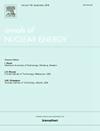PINN and KAN temperature prediction of carbon Fiber/Epoxy composite materials irradiated by nuclear environment simulated intense heat fluxes
IF 1.9
3区 工程技术
Q1 NUCLEAR SCIENCE & TECHNOLOGY
引用次数: 0
Abstract
The carbon fiber/epoxy composite (CFEC) materials in nuclear environments must endure extreme temperature conditions, making the understanding of their thermal response characteristics crucial for material design and safety assessment. Here, the physical information neural network (PINN) was used to develop a fast solver, while the Kolmogorov Arnold network (KAN) was employed to analyze and predict the correlation between multiple experimental parameters and the material’s surface temperature. An ensemble learning method was adopted to integrate six machine learning models and enhance the robustness of prediction. The surface temperature characteristics of CFEC are significantly influenced by radiation and cooling processes in high- temperature environments. The KAN established an explicit functional relationship between Tmax, tmax and input parameters, providing a theoretical basis for optimizing material design. This research contributes to the developing of standards for CFEC performance evaluation under intense heat fluxes, ensuring product quality and safety.
碳纤维/环氧复合材料在核环境辐照下的PINN和KAN温度预测模拟了强热流
核环境中的碳纤维/环氧复合材料(CFEC)必须承受极端温度条件,因此了解其热响应特性对材料设计和安全性评估至关重要。利用物理信息神经网络(PINN)构建快速求解器,利用Kolmogorov Arnold网络(KAN)分析和预测多个实验参数与材料表面温度之间的相关性。采用集成学习方法对6个机器学习模型进行集成,增强了预测的鲁棒性。在高温环境下,辐射和冷却过程对CFEC的表面温度特性有显著影响。KAN建立了Tmax、Tmax与输入参数之间的显式函数关系,为材料优化设计提供了理论依据。本研究有助于制定强热流下CFEC性能评价标准,确保产品质量和安全。
本文章由计算机程序翻译,如有差异,请以英文原文为准。
求助全文
约1分钟内获得全文
求助全文
来源期刊

Annals of Nuclear Energy
工程技术-核科学技术
CiteScore
4.30
自引率
21.10%
发文量
632
审稿时长
7.3 months
期刊介绍:
Annals of Nuclear Energy provides an international medium for the communication of original research, ideas and developments in all areas of the field of nuclear energy science and technology. Its scope embraces nuclear fuel reserves, fuel cycles and cost, materials, processing, system and component technology (fission only), design and optimization, direct conversion of nuclear energy sources, environmental control, reactor physics, heat transfer and fluid dynamics, structural analysis, fuel management, future developments, nuclear fuel and safety, nuclear aerosol, neutron physics, computer technology (both software and hardware), risk assessment, radioactive waste disposal and reactor thermal hydraulics. Papers submitted to Annals need to demonstrate a clear link to nuclear power generation/nuclear engineering. Papers which deal with pure nuclear physics, pure health physics, imaging, or attenuation and shielding properties of concretes and various geological materials are not within the scope of the journal. Also, papers that deal with policy or economics are not within the scope of the journal.
 求助内容:
求助内容: 应助结果提醒方式:
应助结果提醒方式:


